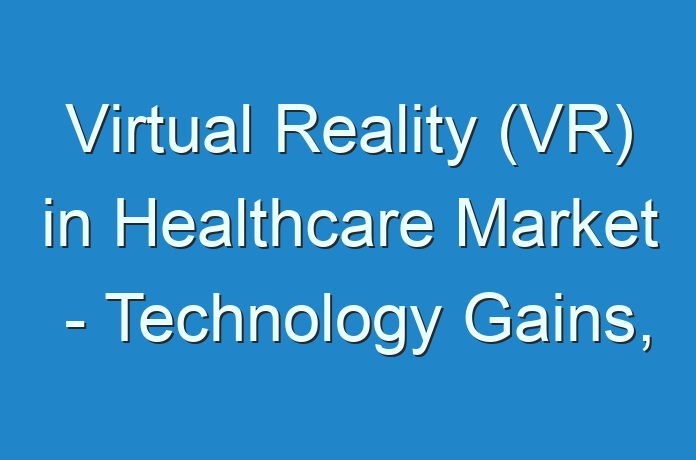
The waves of technological advancements have touched the shores of many sectors and businesses. Artificial Intelligence (AI), Virtual Reality (VR), and Machine Learning are prominent technologies having a huge impact in numerous applications. The healthcare sector is no exception.
- The growing influences of technologies like virtual reality in the healthcare sector are helping in providing quality treatment to many individuals. All these aspects will bring extensive growth prospects for the virtual reality in healthcare market during the assessment period of 2016-2024.
- Minimally invasive surgeries are widespread across the healthcare sector. Virtual reality in healthcare is used for training and aiding surgeons and healthcare professionals in every aspect. Hence, based on all these factors, the virtual reality in healthcare market will invite tremendous growth opportunities across the forecast period of 2016-2024.
- The virtual reality in healthcare market is spreading its influence rapidly across the COVID-19 pandemic. The outbreak has led to the faster adoption of telesurgery among a considerable chunk of the populace. These factors are helping in increasing the growth rate of the virtual reality in healthcare market. Strategic collaborations and partnerships are also playing a crucial role in the growth of the virtual reality in healthcare market.
Virtual Reality (VR) in Healthcare Market – Overview
The integration of IT solutions and principles in the field of healthcare is bringing about a transformation in the way patients are treated and services are provided by healthcare practitioners. The vast benefits of digitally managed processes and operations are prompting an increasing number of companies in the healthcare sector to shift from conventional manually operated devices and processes to newer and more efficient software-enabled solutions. An emerging technology to have become a prominent part of the rapidly digitizing healthcare industry is virtual reality (VR) – a computer enabled technology used to simulate three dimensional interactive virtual environments.
This report on the global virtual reality in healthcare market presents a complete analysis of the key trends observed in the market in the past and present times, growth drivers, and restraints. The report predicts the way the market and its key segments will grow under the influence of these factors over the period between 2016 and 2024. Market’s growth prospects in terms of revenue are mentioned in the form of US$ mn/bn over the said period. The report analyzes the future growth prospects of the market and its segments on global as well as regional levels.
Ask for brochure:
https://www.transparencymarketresearch.com/sample/sample.php?flag=B&rep_id=2282
The report also includes a thorough overview of notable developments in technology to have hit the market in past few years, Porter’s five forces analysis of the competitive landscape of the market and the detailed business profiles of some of the key vendors operating in the global virtual reality in healthcare market. A detailed examination of the various macro as well as micro-economic factors influencing growth prospects of established players and new entrants in the market is also included in the report.
Virtual Reality (VR) in Healthcare Market – Drivers and Restraints
The vast benefits of virtual reality in healthcare, such as easing the way to educate healthcare practitioners, trainee medical students, or patients about surgical and therapeutic procedures, making it easy for surgeons to visualize operating areas closely, and making image guided surgeries more efficient, are the prime factors boosting the adoption of this technology. Although the technology is in its nascent stage of commercialization and usability for medical applications, its use has significantly increased across medical schools and hospitals and manufacturing facilities for medical equipment. There is also a rapid rise in the applications of virtual reality principles in the healthcare industry, the set of which is expected to swell as the technology matures.
The high costs of virtual reality software and supportive hardware devices could emerge as one of the key hinderers for the market’s otherwise excellent growth prospects, especially in emerging economies. Nevertheless, the vast funds being poured in the field of education in emerging countries such as India and China are expected to fuel the adoption of virtual reality in the field of medical education, inevitably supporting the growth of the virtual reality in healthcare market across these countries as well.
PreBook now:
https://www.transparencymarketresearch.com/checkout.php?rep_id=2282<ype=S
Virtual Reality (VR) in Healthcare Market – Segmentation
The report segments the global virtual reality in healthcare market on the basis of criteria such as application and geography. On the basis of application, the market is segmented into categories such as rehabilitation and therapy procedures, surgery, visualization, and education and training. On the basis of geography, the report presents rich insights into the present state of the market in regional markets such as North America, Europe, Asia Pacific, and Middle East and Africa.
Virtual Reality (VR) in Healthcare Market – Companies Mentioned in the Report
Some of the key companies operating in the global virtual reality in healthcare market profiled in the report are GE Healthcare, Virtual Realties Ltd, Virtalis Ltd, CAE Healthcare, Stryker Corporation, Brainlab AG, Philips Healthcare, Siemens Healthcare, Intuitive Surgical, Inc., Vital Images, Inc., and Medtronic, Inc.
Read Latest News Publication:





